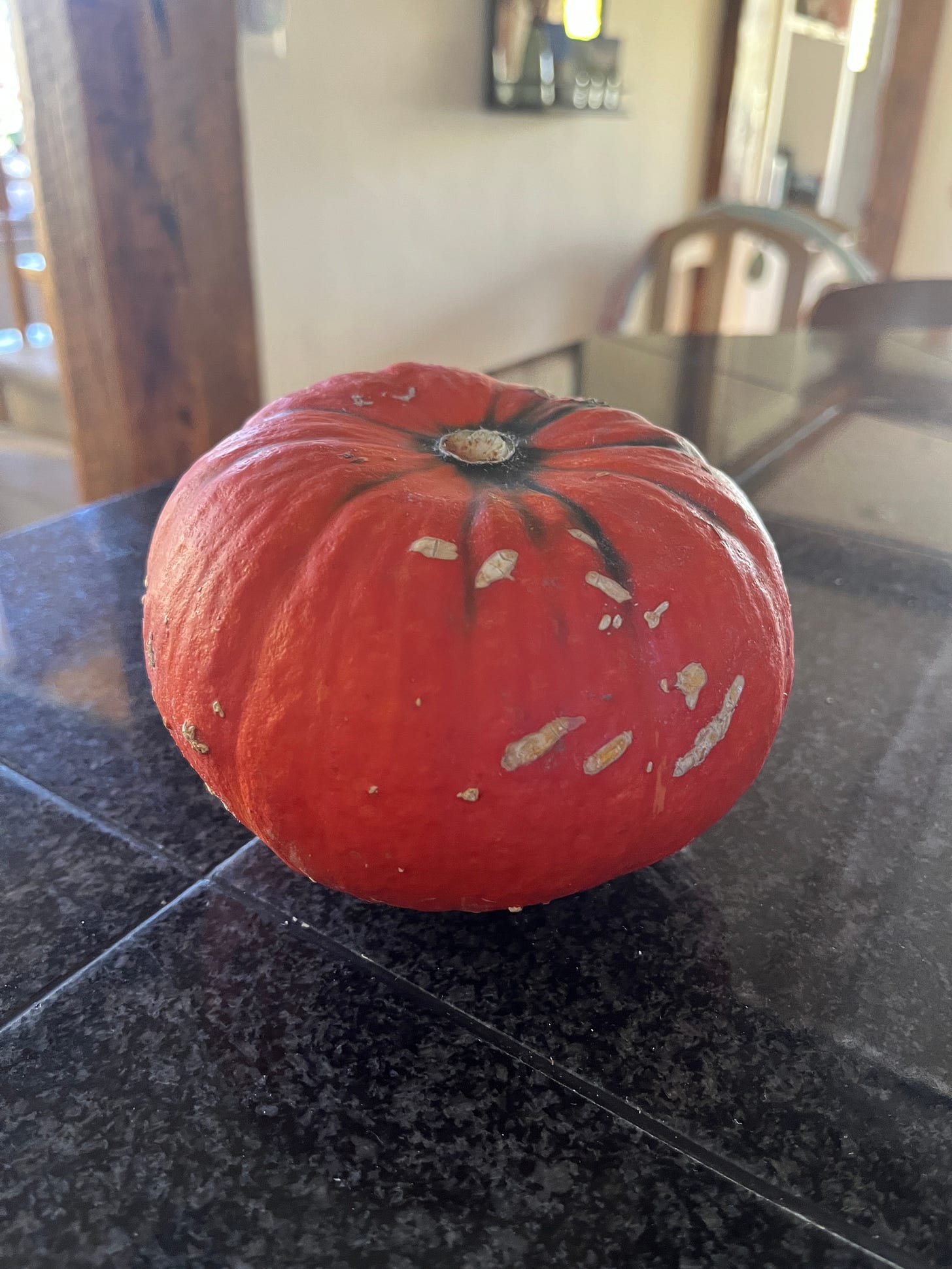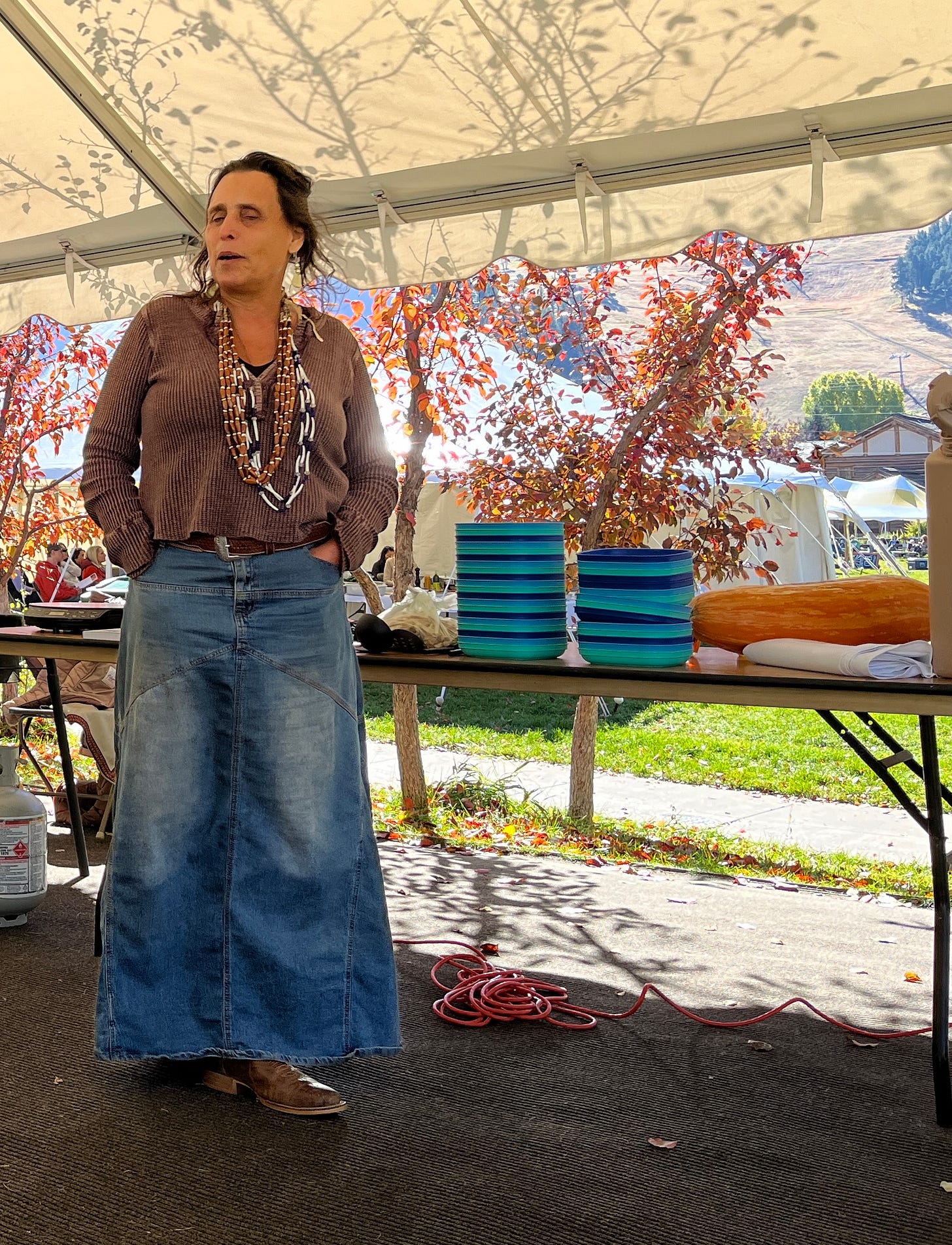Curiouser and Curiouser
about Winter Squash

Photo Red Kuri
Winona LaDuke brought along some props when she presented in Jackson last week. She had her hemp and her wild rice, but she also toted around a very large squash that looked like a dusty orange torpedo—a pink banana jumbo squash.
There are many varieties of winter squash, like the dizzying varieties of Cheerios and Oreos available today, half an aisle each in the grocery store. The squash family doesn’t get the same respect at our local Broulim’s grocery store; they are all piled helter-skelter into a huge box, a jumble of orange and green that challenges classification. It’s best to educate yourself about the characteristics of each variety to make an informed choice. This guide to winter squashes on The Kitchn site is an excellent resource.
I have lots of experience with butternut and acorn squash, and somewhat limited experience with a stuffed Blue Hubbard as a centerpiece at a long ago vegetarian Thanksgiving, but there is a whole world of squash out there and they are all very good for you.
Last year at Sean Sherman’s cooking demo at the Slow Food Farm to Fork festival I learned about Red Kuri squash when he cooked it up on stage. There is no need to skin this one because the skin is edible once it is cooked. The flavor is sweet and nutty and takes very well to roasting. It was a revelation—no peeling required! I was reminded of my ah-ha moment at a cooking demo with Latin chef Daisy Martinez when she showed me how to chop cilantro, stem, and all. I’ve never stripped off those feathery cilantro leaves since then.
The Red Kuri squash is available now if you look for it in grocery stores, farm stands, or at the farmers markets that are still operating. It is actually a member of the Hubbard squash family, just a smaller cousin with a sweeter flavor. All winter squash could be classified as superfoods, foods that contain phytonutrients that combat inflammation and help control blood sugar spikes due to a low glycemic index. Squash also contains polysaccharides, indigestible fiber that can prevent blood sugar from rising after eating. The beta-carotene and lutein in squash are flavonoids that help to protect our cells from the effects of oxygen and may have a role in inhibiting cancer cell growth. Squash is also heart-healthy because it is rich in potassium and helps to regulate sodium and manage blood pressure. How can we add more of this superfood to our diet?
Last year I found a recipe on the New York Times food section that had me tracking down Red Kuri well into December when they got too scarce to find. The recipe is by Kay Chung (which you won’t be able to access unless you have a NYT account) and calls for Kabocha squash. I made some other adaptations to it but her basic method deserves all the credit. I like keeping the squash in larger pieces so they look like “smiles” when you place them on top of the greens.
Here's my version of the salad. Check it out.
Red Kuri Squash and Endive Salad with Sesame Vinaigrette
Makes 8 servings
2 pounds Red Kuri squash, halved, seeded, and cut into wedges
6 tablespoons olive oil
Salt and pepper
2 tablespoons sesame seeds
2 tablespoons tahini
Juice of one lemon
1 teaspoon toasted sesame oil
1 teaspoon tamari or soy sauce
3 cloves crushed garlic
1 tablespoon water
6 ounces curly endive, cleaned and stems removed, chopped
8 scallions, sliced on the diagonal for garnish
Preheat the oven to 450° F. In a large bowl, toss the wedges of squash with 2 tablespoons of olive oil and salt and pepper to taste. Arrange the coated squash wedges on a baking tray in a single layer. Roast in a hot oven for 15 minutes then flip each slice to brown the other side and roast for an additional 15 minutes.
Toast the sesame seeds until golden brown and fragrant in a small dry skillet. Place half the seeds into a large bowl and reserve half for garnishing the finished dish.
Add the tahini, lemon juice, sesame oil, tamari, garlic, and a tablespoon of water to the large bowl and whisk vigorously. Drizzle in the remaining 4 tablespoons of olive oil and whisk vigorously to emulsify. Adjust the dressing with salt and pepper to your taste. Split the dressing, taking half out to drizzle on top of the squash. Toss the endive with the salad dressing in the bowl and divide onto individual salad plates or pile it all onto a serving platter. Arrange the Red Kuri “smiles” on top and drizzle with the remaining dressing. Scatter the toasted sesame seeds and scallions on top. Serve with a smile!








Love the article and the recipies ! 👍